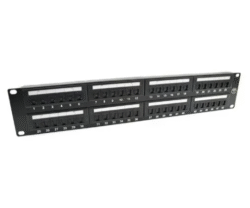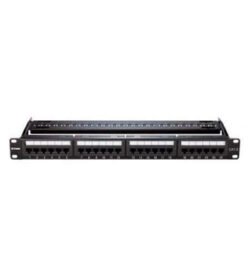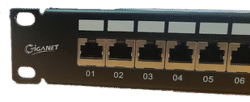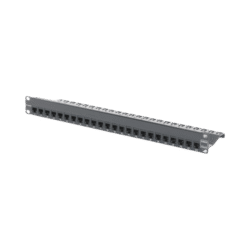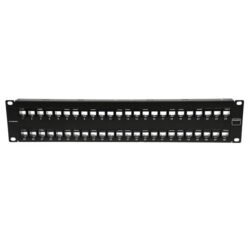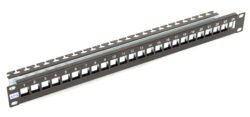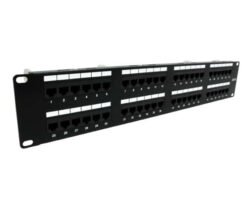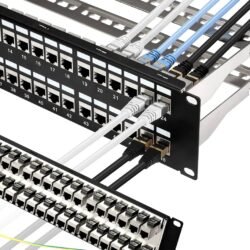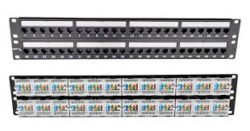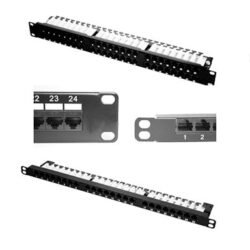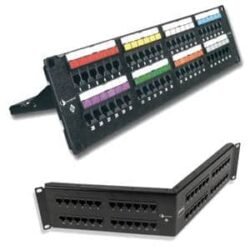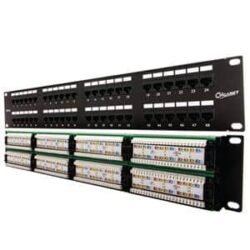What Is a Patch Panel and Why Is It Essential for Your Network
A patch panel serves as an organized, centralized connection point for both incoming and outgoing network cables in a Network Cabinet Rack or Data Cabinet Rack in structured cabling solutions
Path panels when used together with cable managers help in centralizing cable termination and cable management, it simplifies network management, enhances reliability, and enables easier network scalability. This makes patch panels a critical component in both small and large network setups across Kenya, from offices to data centers.
Types of Patch Panels and Their Best Uses
| Type | Description | Best For |
| Punch-Down Patch Panel | Uses Insulation Displacement Contact (IDC) terminals requiring a punch-down tool. Connections are permanent and stable. | Large-scale, permanent network deployments in data centers and enterprises where signal reliability is critical. |
| Keystone (Modular) Patch Panel | Empty slots accommodate modular “keystone” jacks for different connection types like RJ45, HDMI, or fiber optics. | Media networks or setups needing high flexibility with various connections. |
| Feed-Through (Coupler) Patch Panel | Contains RJ45 couplers on both sides allowing tool-free, plug-and-play installation. Fastest deployment option. | Quick setups, small offices, or temporary installations. |
| Angled Patch Panel | Ports are angled for efficient cable routing to vertical cable managers, increasing rack density. | High-density data centers with limited space. |
| Shielded Patch Panel | Features metal housing and grounding to protect against electromagnetic and radio frequency interference (EMI/RFI). | Industrial or high-interference environments near electrical equipment. |
Recommendations for Choosing Patch Panels in Kenya
- Match Your Cabling: Network performance is limited by the weakest component. For instance, using a Cat6 patch panel with Cat5e cables will limit network speed to Cat5e standards. Always pair patch panels with matching cable categories for optimal performance (e.g., Cat6 panel with Cat6 cables).
- Prioritize Modularity: Choose an unloaded keystone patch panel—like the Siemon, Giganet and APS UTP/STP Unloaded Patch Panel 24 Port or Molex Unloaded Keystone Patch Panel—to allow flexibility. These let you install different keystone jacks as needed, accommodating various media types and future network expansions without replacing the entire panel.
- opt for Shielded Panels in High Interference Areas: If your network cables run near sources of electromagnetic interference, use shielded patch panels such as the Siemon 6A Shielded Patch Panel. Distributors like TDK Solutions Ltd in Kenya offer options ideal for high-speed, 10-gigabit networks in noisy environments.
- Consider Angled Panels to Save Space: For data centers or network rack setups with limited space, an angled patch panel can improve cable management and rack density. Giganet and Siemon’s UTP Angled Patch Panel 24 and 48 Ports is tailored for such high-density environments.
- Label Ports Clearly: Regardless of the panel type, implement a consistent labeling system for each port. Clear labels are crucial for troubleshooting and long-term maintenance. Check out Network cable labeling machine price in Kenya
Key Installation and Maintenance Tips for Patch Panels
- Mount Securely: Whether in a rack or on a wall, secure your patch panel firmly. Using a plywood backboard can add stability.
- Manage Cables Neatly: Use hook-and-loop straps instead of plastic zip ties to prevent overtightening and potential cable damage.
- Terminate Properly: Use the appropriate punch-down tool for your panel and consistently follow wiring standards like T568A or T568B.
- Leave Service Loops: Allow extra slack near terminations to ease future adjustments or re-termination without needing new cable runs.
- Test Every Connection: After installation, use a network cable tester to verify that all connections work properly before deploying the network.
By understanding the different patch panel types and following best practices in selection, installation, and maintenance, Tdk Solutions is your ideal IT Company to help you build more reliable and scalable networks that stand the test of time
Network Patch panels Prices
Network Patch Panels
D-Link 48 Port Cat6 Unshielded Fully Loaded Punch Down Patch panel
Network Patch Panels
Network Patch Panels
Network Patch Panels
Network Patch Panels
Cat6a UTP Unshielded RJ45 Ethernet Network Patch Panels 48/24 Ports
Network Patch Panels
Network Patch Panels



